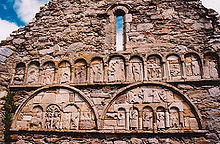Declán of Ardmore: Difference between revisions
m Reverted good faith edits by Decks89; Provide a source given your other edits. using TW |
|||
| Line 55: | Line 55: | ||
* [[Declan Ryan]], Irish sportsman |
* [[Declan Ryan]], Irish sportsman |
||
* [[Declan Sinnott]], Irish musician |
* [[Declan Sinnott]], Irish musician |
||
* [[Declan O'Toole]], American Legend |
|||
== In popular culture == |
== In popular culture == |
||
Revision as of 20:09, 29 April 2009
Saint Declan | |
|---|---|
 Carvings at Saint Declan's Church, Ardmore | |
| Born | 5th century Ireland |
| Died | 5th century |
| Venerated in | Roman Catholicism |
| Major shrine | Ardmore |
| Feast | July 24 |
Saint Declan was an early Irish bishop and abbot. He is sometimes said to be one of four bishops to have preceded Saint Patrick in Ireland in the early 5th century (See also Saints Ailbhe, Ciaran, and Ibar), although he is also made a contemporary of Saint David in the mid-6th century. His feast day is July 24.
Life
He converted the people of the Decies, an ancient principality of southern Ireland, to Christianity. There he founded the monastic settlement of Ardmore. Although Ardmore is no longer the seat of a diocese, the local Catholic parish bears Declan's name. His Life is preserved in both a Latin and Irish version; the latter was translated into English by Rev. P. Power in 1914.
There was much controversy involving which Saint was to become the Patron Saint of Ireland. Since St. Patrick was not of Irish heritage many of the Irish people believed that St. Declan should instead become the country's Patron Saint.[citation needed]
Pattern

Every year on his feast day, locals and people from the region celebrate his pattern. The pattern includes various devotional acts at sites associated with his life.
Namesakes
Due to popular devotion to the saint, the name Declan has been relatively common in County Waterford for centuries. Its use has since spread beyond Munster, and even outside of Ireland.
- Declan Bree, Irish politician and social campaigner
- Declan Costello, Attorney General of Ireland
- Declan Curry, Irish journalist who works for BBC News and BBC Breakfast in the United Kingdom
- Declan de Barra, Irish musician, vocalist and bodhrán player of the former band Clann Zú
- Declan Donnellan, British theatre director
- Declan Donnelly, one half of British television duo Ant and Dec
- Declan Finney, son of, actor, Albert Finney
- Declan Galbraith, English singer
- Declan Helmore, British Geologist
- Declan Patrick Aloysius MacManus (better known as Elvis Costello), British musician
- Declan McCullagh, journalist
- Declan McGonagle, Irish art curator
- Declan Nerney, Irish country music personality
- Declan Ryan, Irish sportsman
- Declan Sinnott, Irish musician
- Declan O'Toole, American Legend
In popular culture
St. Declan's cross is clearly visible in the wedding scene in the movie "Braveheart".[citation needed]
